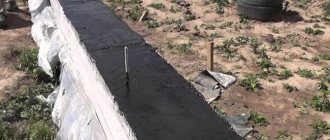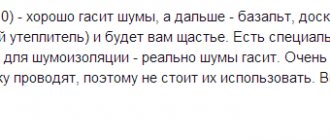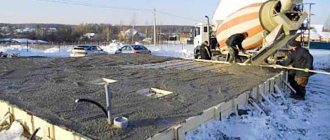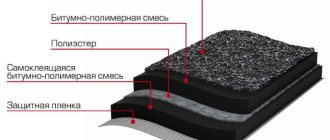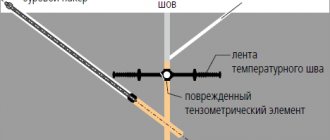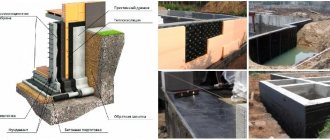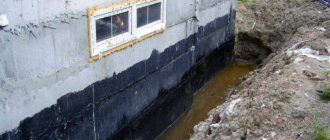Why do waterproofing in winter at sub-zero temperatures?
Putting off waterproofing until later may not be such a good idea, as it could cause even more damage to your home, and here's why:
- In the presence of groundwater, heavy rainfall or melting snow, the soil around your home becomes saturated with moisture. If your foundation and its walls are located below ground level, then the concrete from which your foundation is made, in the absence of waterproofing, will absorb moisture (concrete and brick absorb water very well), which freezes at sub-zero temperatures, and when spring comes it thaws, thereby destroying concrete and, accordingly, your foundation. When frozen water thaws, microcracks, voids and pores form in concrete, through which water can subsequently seep in and flood your basement. If the brand of concrete is not very good or when it was poured it was poorly vibrated and, as a result of the lack of waterproofing, absorbed moisture, then a temperature difference from negative to positive can lead to a more serious consequence, such as cracks on the surface of the foundation and walls.
- Russian winters tend to have a freeze/thaw cycle, causing your home and the ground around your foundation to expand and contract at different rates and rates. This tends to enlarge existing cracks and open seams through which water can penetrate.
- With the onset of frost, so-called icing occurs, which clogs many pipes, gutters, trays, downpipes and drains. When these support elements stop allowing water to pass through, it finds an alternative path, increasing its presence around the foundation of your home or building and increasing the risk of it getting inside.
How to choose a foundation waterproofing method (coating waterproofing)
Waterproofing underground structures is a task that requires a serious approach. Surfaces that are constantly exposed to water, for example, the walls of foundations, basements, canals, reinforced concrete tanks, etc., require waterproofing that can maintain its properties for a long time.
There are several ways to carry out waterproofing work.
Injection waterproofing are materials based on mineral, polyurethane, epoxy and other bases. Using pressure, through specially prepared holes, the material penetrates the structure of a concrete, brick or other wall, solidifying in the pores and capillaries, creating a horizontal cutoff, preventing moisture from rising higher. This method of waterproofing is mainly used when it is impossible to free the foundation from the soil and carry out coating waterproofing. This method is expensive and requires not only specialized equipment, but also the skill of the workman.
Penetrating waterproofing - Penetrating materials are made from cement with additives of chemically active substances and specially crushed sand. It is mainly used for internal waterproofing of foundations and basements, as well as for the repair of concrete structures. During operation, upon contact with water, the chemical reaction continues, and the sealing process continues - self-healing of concrete occurs. This results in a double waterproofing effect: waterproofing of the outer layer and crystallization of the pores inside the concrete. This material can be used both during reconstruction and new construction, if access to external surfaces is limited, and the only way to install waterproofing is to work from inside the room. This method is more suitable for fresh concrete. When repairing old concrete, it is necessary to mechanically clean the surface of plaster and degrease it to open access to the capillary system of the surface.
Coating waterproofing is a single-layer or multi-layer coating with a thickness from a millimeter to several centimeters. It is used for external protection of the house from groundwater, and internal protection from capillary moisture. Coating waterproofing includes cement-based materials, but the most popular are bitumen-based materials. Waterproofing using bitumen and bitumen-polymer mastics TECHNONICOL refers to coating waterproofing.
As a result of processing a concrete or metal pile in this way, a film is formed that allows it to effectively retain moisture, preventing deformation of the base material. The advantage of this type of foundation waterproofing is a high degree of protection of the entire surface of the concrete slab or metal pile and the absence of special training for the person carrying out the work. This is the most affordable method of waterproofing, both in price and in simplicity of the device.
Selection of mastic based on bituminous materials
The choice of bitumen material for coating waterproofing depends on many factors:
- Ambient temperature during work
- Waterproofing will be carried out on internal or external surfaces
- What is the area of the surface to be treated and the timing of the work?
- Planned loads on finished waterproofing coatings during operation
- Budget for waterproofing work
The answers to these simple questions will help you make the right choice of material. And they will provide an opportunity to save money without compromising the quality of the coating waterproofing of the foundation.
The use of hot bitumen is most often characterized by a low price per square meter. This is the most ancient method of waterproofing; over time, only the amount of additives has changed, making the material more elastic and penetrating. The disadvantage when choosing this type of material is the need for additional heating equipment at the construction site to convert the mastic into a liquid consistency and stricter compliance with safety regulations to avoid burns and injuries. You can work with such material at subzero temperatures.
To avoid such difficulties, you can choose mastics based on organic solvents. This is the most common method of installing bitumen coating waterproofing. To carry out the work, an ordinary brush or spatula is enough; the workman does not require any additional skills. Depending on the type of work performed, you can choose conventional bitumen mastic with a solvent or bitumen mastic with the addition of polymers . Polymers add additional qualities to the material in terms of elasticity, quality of adhesion to the base, and increases the temperature range of use of the material. In other words, adding polymer to bitumen mastic makes it possible to use the material on the roof, but increases the cost of the material itself. Therefore, for most simple work on installing coating waterproofing of foundations, ordinary bitumen mastic is quite sufficient. These mastics can also be used at subzero temperatures.
If you need to carry out work in the internal parts of the foundation from the basement side, where there is not sufficient air access, carrying out work using solvent-based mastics may become unsafe for the person doing the work. For this purpose, there are water-based bitumen mastics (emulsions) . This type of material is no different in characteristics from solvent-based mastics, but due to its water base, it does not contain solvents, has a neutral odor and is ideal for indoor use. This mastic has a shorter drying time, but the temperature range of application is reduced to a lower level of at least +5C.
In cases where it is necessary to carry out work on large areas in a short amount of time, bitumen-latex emulsions for mechanized use (liquid rubber) . With different labor productivity, the surface area to be processed can be 1000 m2 in 8 hours.
TechnoNIKOL Corporation produces all of the above types of bitumen-based mastics for coating waterproofing of foundations and basements. You can choose the one that is most suitable for you in the catalog on the website www.mastiki.tn.ru
How to make waterproofing at sub-zero temperatures? Technology and Regulatory Requirements
In order to waterproof in sub-zero temperatures, you must do one of two things:
1. Create a thermal circuit where a positive temperature will be maintained: From the inside: If we are talking about indoor work, then it will be enough to cover windows, doors and other places through which cold air can pass with reinforced film and install a heat gun to maintain the required temperature. waterproofing room temperature. Outside: It is necessary to install a greenhouse around the walls of the basement, foundation, plinth, roof section or any other surface where you plan to apply waterproofing. The greenhouse can be made of wooden sheathing and reinforced film or tarpaulin (see photo). Next, in this greenhouse, a heat gun is installed, maintaining the desired temperature in the work area.
Important: Under no circumstances, day or night, do not leave the area where an electric or diesel heat gun is operating unattended - this could result in a fire!
Important: Don’t forget, when it’s winter outside, the positive temperature in the work area must be maintained not only at the time of applying the waterproofing material, but also during its formation and drying (each material has its own time for setting with the surface).
or
2. Use special waterproofing materials
Today on the market, there is a fairly large number of waterproofing materials that can be applied in negative temperatures down to minus 20 degrees. When choosing such a composition, you must definitely pay attention to the instructions for its application and the requirements for preparing the surface for its application. Sometimes the surface needs to be heated with burners to a certain temperature.
Important: when performing work in sub-zero temperatures, it is important to pay attention to 3 things:
- Proper preparation and drying of the surface
- Instructions for storing materials before use
- Application instructions
Bitumen membranes
If you work with welded roll material during the cold season, you need to ensure that the temperature of the material itself is not less than the flexibility of the sealant. This data can be found on the packaging; it is indicated by the manufacturer.
In sub-zero weather, rolled materials should be kept at room temperature for at least a day before applying insulation. It is important that the temperature in the room does not fall below 15 degrees.
Weld-on seals should not be used during fog, rain, or when there is frost or frost on the concrete surface. In such weather conditions, the foundation must be dry and warm.
If weather conditions are unfavorable, then during waterproofing work you should use greenhouses or canopies, and provide the necessary conditions.
Waterproofing in winter - Selecting materials
Today there are quite a lot of materials on the market that allow you to install waterproofing in winter down to -25°C:
- Membrane coverings made of PVC base and ethylene propylene
- Coating compositions and mastics based on bitumen and polymer-bitumen
- Polymer mastics
- Roll welded materials
- Injection waterproofing
Mounted membranes
The most popular type of waterproofing membranes is PVC membranes. Thermoplastic polymer membranes do not lose their properties even at -25°C. PVC membranes can also be installed in winter, since they are attached mechanically and the seams are joined with hot air. In winter, this type of membrane must be kept at a temperature not lower than +10°C for at least 12 hours before installation. You can maintain the material at above-zero temperatures, for example, in a heated greenhouse.
Bitumen-based coatings and mastics
Not all bitumen mastics can be applied when the outside temperature drops below zero. The most famous bitumen-based coating materials that allow waterproofing work to be carried out in harsh climatic conditions are TechnoNIKOL No. 24 from the TechnoNIKOL manufacturing company and flexLock Pro from the German company HYDRO.
Polymer mastics
There is polyurethane waterproofing that can be applied negatively, for example, one of the modifications of PolyFlex polyurethane mastic from the German company HYDRO. Before applying most polyurethane mastics in sub-zero weather, they must first be kept for 12 hours in a special heated tent.
Roll welded
If we take high-quality weld-on membranes that can withstand sub-zero temperatures, then with the right approach to their storage and installation, they can be used as a waterproofing coating in winter.
The following types of fused materials are suitable for winter conditions:
- Technoelast
- Uniflex
- Bipole
Before installation, these materials must be kept in a warm place for at least 24 hours at a temperature not lower than +15°C. Just before the installation, the materials are removed from the warm room directly to the work site.
The ambient air temperature and the temperature of the material itself must be higher than the flexible temperature of the material:
- Technoelast – no higher than -25°C;
- Uniflex – no higher than -20°C;
- Bipole – no higher than -15°C.
Important: When working with the above materials, it is necessary to use a torch and gas cylinders. To increase the efficiency of working with gas equipment in winter, as well as to ensure the safety of such work, it is necessary to install a special heater for cylinders, which ensures stable gas pressure in the cylinder.
Injection resins and gels
These compounds are injected under pressure into concrete or brick using special equipment. When maintaining positive °C indoors, they can be injected even when the air temperature outside is below 0. One of the most popular injection compounds in industrial insulation is HydroInject.
General requirements for waterproofing work in winter:
- use only special frost-resistant materials;
- strict adherence to waterproofing technology and operating temperature conditions specified in the technical documentation for the treatment means;
- thorough preparation and cleaning of the surface from ice, dirt, snow and water;
- comprehensive protection of the waterproofing area from the effects of aggressive weather factors;
- if work is carried out outside at temperatures below +5°C, the use of greenhouses is mandatory;
- thorough drying and heating of the foundation to the required levels;
- protection of materials from exposure to cold, careful storage and transportation.
If the hydraulic protection of the foundation is carried out using rolled materials, they are kept for 24 hours indoors at a temperature of +15-20 degrees Celsius. Bitumen mastics are applied in winter only in conditions down to -10 °C, PVC membranes - not lower than -15 °C. Cement-based materials are used only if the air temperature over the last 24 hours has not dropped below +5 °C. In this case, the surface on which such a mixture is applied must be checked for the presence of free water; it should not be there.
Waterproofing by injection is free from all of the above problems. It can be performed in a wide range of temperatures, does not require an absolutely dry surface and does not require excavations in frozen soil.
Waterproofing the foundation for the winter at sub-zero temperatures
Waterproofing your foundation and basement can be done in winter, but it depends on the waterproofing systems used. If the house is not excavated, then exterior basement or foundation waterproofing involves excavating around the perimeter of the house so that the foundation can be excavated to the bottom of the slab, usually by hand or machine. In winter, ground work becomes more difficult as the ground freezes. Frozen soil is very difficult to dig, which leads to an increase in the cost of the process by at least 2 times. In this regard, if the house is not excavated around the perimeter, and you need to protect it from water, then it is best to do it from the inside, using special compounds that work on negative water pressure, such as polymer-mineral cement insulation or injection waterproofing, such as Hydroinject.
If the foundation has access from the outside, then insulation in winter can be done using waterproofing, which can be applied at subzero air temperatures, or by installing a greenhouse.
Waterproofing foundations in winter in St. Petersburg!
Many people have a question about what materials are best to use and how to work with them correctly in winter, because most do not even know that it is possible to do waterproofing in winter.
What materials are used to protect concrete surfaces from water?
- Mixtures based on cement additives
- Bitumen mastics
- Bitumen membranes
- Bentonite materials
How to protect the integrity of foundations using a mixture based on cement additives?
It is imperative to emphasize that all activities must be carried out at a temperature not lower than +7 - +5 degrees, this can be either inside the assembled greenhouse or in an open state.
The solution with the addition of a cement mixture is made exclusively on the basis of clean water, without impurities and silt sediments, which are often found in wells. The solution must be prepared indoors at a temperature not lower than +25 - +20 degrees. The application of such waterproofing on the surface of the foundation is carried out without haste and can be applied to both wet and dry surfaces.
Bitumen mastics for winter waterproofing
There are two main types of bitumen mastic, cold (solvent-based) and cold (water-based). Similar materials are also applied at positive temperatures.
The temperature should be no lower than -10 - -15 degrees, and the surface of the foundation should be heated to a temperature of at least +7 - +5 degrees. Working with bitumen mastic itself is not the easiest and it is best to follow all the rules for using these materials.
A prerequisite when applying bitumen is preparing the surface and cleaning the concrete from dust, dirt, ice, snow, etc. The surface on which bitumen is applied must be heated to a temperature not lower than +7- +10 degrees. Also, when applying waterproofing in winter, bitumen mastics must be heated so as not to disrupt the technology for applying these materials.
Bitumen membranes for waterproofing in winter
Fused roll waterproofing is very common in construction and is often used to protect concrete foundations. To work in winter with this type of waterproofing, you need to very carefully monitor the air temperature and avoid critical levels, otherwise, instead of insulation, you will only get a low-quality coating that will crack over time and will not serve its role.
The built-up waterproofing for the foundation is applied at a temperature not lower than at which its plasticity will be lost. Before use, it is better to refer to the instructions for all temperature conditions and only after calculating all the risks proceed to work.
If work is carried out at subzero temperatures, it is better to keep the rolled waterproofing in a warm room at a temperature of +22 - +25 degrees, so that its plasticity is maximum.
It is very important to note that the built-up waterproofing is applied to a prepared surface, previously dried and heated to at least +10 degrees. Burners are usually used for heating. Unlike materials such as dry cement mixtures, built-up insulation covers 100% of all existing seams and cracks in the foundation, thereby creating a powerful water-repellent surface, increasing the service life of the foundation and repelling groundwater.
To protect the foundation, it is necessary to select exactly the materials that will be most convenient to work with and that will justify their cost in each specific case.
Waterproofing concrete at subzero temperatures
Pouring concrete:
If you pour concrete in winter or at negative external temperatures, then you are violating the concrete pouring technology. In order to avoid disruption of the technology and the subsequent formation of cracks and voids in it, it is necessary to apply the following technology:
- Use special additives and additives for concrete and masonry mortar - Antifreeze additives are used at temperatures down to -15°C and have the ability to increase the rate of hardening and plasticization of concrete. Some additives also improve its hydrophobic properties.
- After pouring concrete, use thermomats - special devices that resemble mats, thanks to which the concrete composition hardens at the required temperature (according to the standards and laying technologies).
Only after the concrete has gained the necessary strength and hardened can you begin to directly protect it from the penetration of water and moisture.
Waterproofing concrete:
If you plan to waterproof concrete in winter, this can be done in the following ways:
- Use special additives for concrete
- Use materials that can work at a disadvantage
- Create a thermal contour around the work area
Drainage in winter - is it possible to do drainage in winter?
Drainage is a special system designed to drain water away from your building, foundation or home.
In order to answer the question whether it is possible to do drainage in winter, you need to understand what this drainage consists of and how it is installed.
Stages of constructing a drainage system:
- Ground work - a trench is dug manually or using machinery to the required level, observing the slope marks.
- Installation of geotextile with outlets
- Construction of a crushed stone base - the drainage trench is filled with gravel crushed stone of fraction 20-40 to a thickness of 0.2-04, taking into account the slope marks.
- Installation of flexible drainage pipe and drainage manholes
- Filling the pipe with crushed stone to a thickness of 0.1-0.3 and covering it with pre-prepared geotextile
- Backfilling the trench with river sand, washed, coarse-grained - it is this kind of sand that has the maximum water throughput and without proper backfilling, drainage simply will not work.
The answer to the above question is Yes. You can do drainage in winter . If you look at the listed stages of installing a drainage system, you can immediately understand that there is no obstacle to installing drainage at sub-zero temperatures, except for the difficulty in excavating the soil, since frozen soil is very difficult to dig.
Advantages and disadvantages
The general advantages of bitumen mastics from this manufacturer include:
- ease of application (all formulations are ready for use) and relatively economical consumption;
- the proportion of non-volatile substances is above 50%;
- good strength and adhesion to concrete and metal;
- heat resistance from 80 °C;
- elasticity, crack resistance and water resistance of the resulting coatings.
The disadvantages are manifested in the relatively short shelf life and destruction of the structure at sub-zero temperatures for aqueous emulsions, toxicity and the dependence of drying time on external conditions for mastics based on organic solvents.
Prices vary by brand, but most brands of foundation waterproofing are considered affordable and economical.
Waterproofing and roof repair in winter
When repairing or insulating a roof in winter, you need to consider what kind of roof you plan to repair and what material it is made of. If the material from which the roof is made allows its repair to be carried out in winter, then there are no problems with work when it is minus °C outside.
Roof waterproofing can be done in winter, using appropriate systems designed for negative °C below 0 or when installing a canopy, while maintaining a positive temperature inside.
Contrary to some prejudices and misconceptions, roof repair and replacement work can be carried out during cold winds in winter. And while it may not be the best or most convenient time of year to do a full roof replacement, there can be benefits to having the work done during the winter. Of course, when there are pros, there will definitely be cons.
When you need a roof replacement in the winter, or any other time of year, there are significant benefits to using the services of a qualified roofer. Our specialists have extensive experience in waterproofing, repairing and replacing residential roofs, including in cold winter weather, which, in turn, allows us to:
- Work quickly and efficiently;
- Work on the roof using safety precautions;
- Correctly select and apply waterproofing, taking into account low temperatures;
- Use proper methods to remove snow/ice from the roof;
- Comply with all standards and technologies when repairing or insulating the roof in winter.
Types of bitumen mastic
Mastic based on bitumen can be of different types, it all depends on the composition of the material and the technology of its use. In this regard, the division is carried out according to the following criteria:
Application technology.
This process has two varieties:
- Hot application. The peculiarity of hot mastic is that before application it requires heating to a certain temperature. At the same time, there are mastics with high heat resistance that require maximum temperature to achieve working condition. This includes mastics used as adhesive for roll waterproofing. If bitumen-based mastic is used as an independent coating waterproofing of the foundation, then it heats up to a viscous state with slight heating. Experts do not recommend mixing types of mastics that have different temperature characteristics. Hot bitumen mastic for the foundation requires strict adherence to safety regulations and technological process. Therefore, it is best to invite a specialist to work with hot mastic.
- Cold mastic is applied without preliminary preparation, but requires thorough mixing before use. It is worth noting that applying a cold version of coating waterproofing at subzero temperatures requires some heating.
Dissolution options.
Depending on the components included in the composition, bitumen mastic can be water-soluble or made on the basis of organic solvents. Therefore, you can get a more liquid consistency by diluting with a liquid similar to the mastic base.
Number of components
Bitumen-based mastics for foundation waterproofing can vary in the number of components for preparing the mixture:
- One-component mastics are already ready for use. To work, you need to open the package, mix the mastic and apply it.
- To prepare two-component bitumen mastic, it is necessary to combine two components in compliance with certain proportions. Such mixtures harden quite quickly, so the composition must be prepared immediately before application. Two-component mastics can be stored for a long time in a closed container. In addition, they have high durability during operation.


